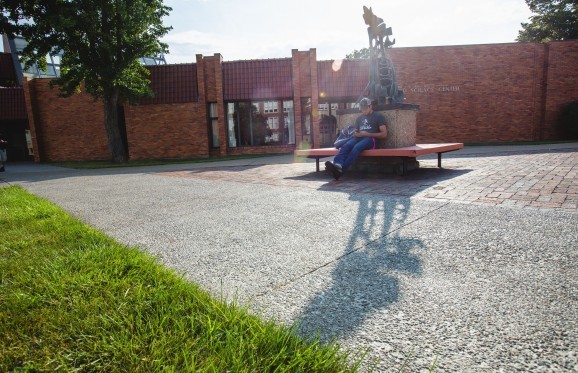Learning
Science Division students present research and internship findings at fall forum
Muskingum University Science Division students presented their research and internship findings at the university’s annual Fall Research and Internship Forum, held October 28.
The following students made presentations:
Tanner Barnes '11 presented Development of a cavern formation simulator in the Python programming language. This research centered on the creation of cavern simulator using the known equations for modeling the dissolution of limestone-based rock, in order to allow geologists to better understand how caves form by speeding up the change from a hairline fracture to a full-size cave.
Seth Barrett '11 presented The making of and electroforming copper metal onto ceramic ovenware. To test ovenware coatings and colors, clay body and glaze formulas were developed and molds were designed to create multiple forms for the ovenware.
Mary K. Richardson '12 presented Utrophin and beyond, with Assistant Professor of Biology Dr. Amy Santas. This project utilized the reference software Endnote to extract pertinent information from scientific articles efficiently.
John C. Bourne '12, Rachel E. Hentz '12 and Douglas R. McClain '11 presented Reproductive success of grassland birds on a reclaimed surface mine in southeastern Ohio. This study centered on the effects of microhabitat on the reproductive success of grassland birds, as well as the biodiversity of bird species.
Kelley Crater '11 presented The Wilds summer internship. This internship involved assisting with veterinary procedures; monitoring anesthesia, running blood work, administering vaccinations, preparing medicine and collecting samples among various animal species.
Erin Lycans '11 presented Audubon Nature Institute’s Center for Research of Endangered Species (ACRES): Animal department intern.The ACRES facility houses scientists whose research programs include studies in reproductive physiology, endocrinology, genetics, embryo transfer and the expansion of a “frozen zoo” to ensure the future of endangered species through the banking of genetic materials.
Ben Skelley '11 presented White-tailed deer (Odocoileus Virginianus) population size estimation at different habitats at The Wilds. In this research, White-tailed deer population size estimation and habitat selection were studied in two different seasons at The Wilds.
Kristen Fuller '10 presented S. Pastorianus Old Yellow Enzyme (OYE) site W116 mutagenesis and subsequent protein expression. This study considered the ability to produce pure enantiomers in industries such as pharmaceuticals, when pure substances are often necessary for proper chemical function.
Richard Blackmore '10 presented Sabercat Creek interpretive trail plan. The long-term project consisted of turning a 14.02 acre area of undeveloped land into an historic park.
Jessica Lade '10 presented Vegetation analysis of the impacts of wildlife grazing on pastures at The Wilds. To provide a greater understanding of grazing impacts, plots were established in four of the five pastures and the data was analyzed after collection.
Amy Miller '10 presented Memory identification in bipartite Pauli channels. The classical communication capacities of quantum Pauli channels with memory are known to exhibit a transition effect, and this study revisited this phenomenon from the standpoint of the functionally analogous task of channel memory identification.
Erik Nesbit '10 presented Summer internship 2009: Physical therapy observation. This internship was an observation of physical therapy as a crucial component in today's health care world as an effective technique to help patients progressively recover to normal physical functions.
J.N. Parrish '11 and five collaborators presented Cognitive processing differences between cocaine exposed and control adolescents.This study investigated the effects of prenatal cocaine exposure on preliminary cognitive processing during an executive functioning task.
Andrea Richard '11 presented Stellar surface imaging of LO Pegasi Via light-curve inversion. LO Pegasi, or star HIP 106231, was observed for the purpose of mapping its starspots.
Joseph Castle '12 presented Development of peptide capture elements against the cognitive protein S6K1, with Dr. Wanda J. Lyon. Detection of cognitive-related proteins could prove vital in detection of memory formation and enhancement of short and long term memory.
Traci Watts '11 presented An ethogram of D-holes (cuon alpinus) in large enclosures at The Wilds. The D-hole is a rare, social dog native to southern Asia that has been studied very little and not much is known about this species social behavior. This study has looked into the behavior of two D-holes being housed at The Wilds in Cumberland, Ohio.
Melissa Mull '10 presented Temperature dependence of the diffusion coefficients of M(BPY)X in Nafion. The goal of this project was to examine the temperature effect on the kinetics and mass transport of different transition-metal bipyridine ligand complex redox probes in Nafion.